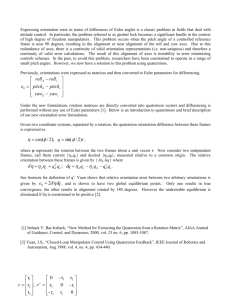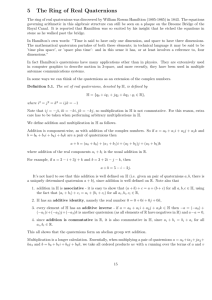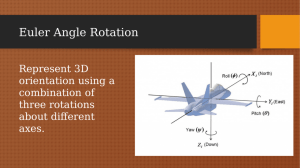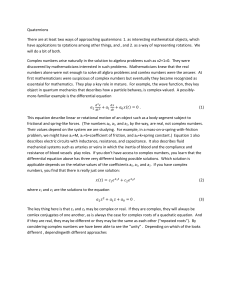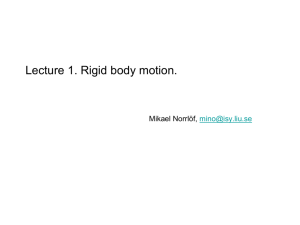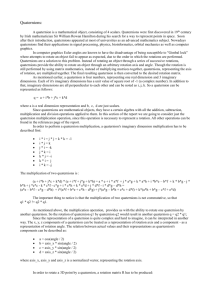Quaternion Orientation Interpolation with Velocity Constraints
advertisement
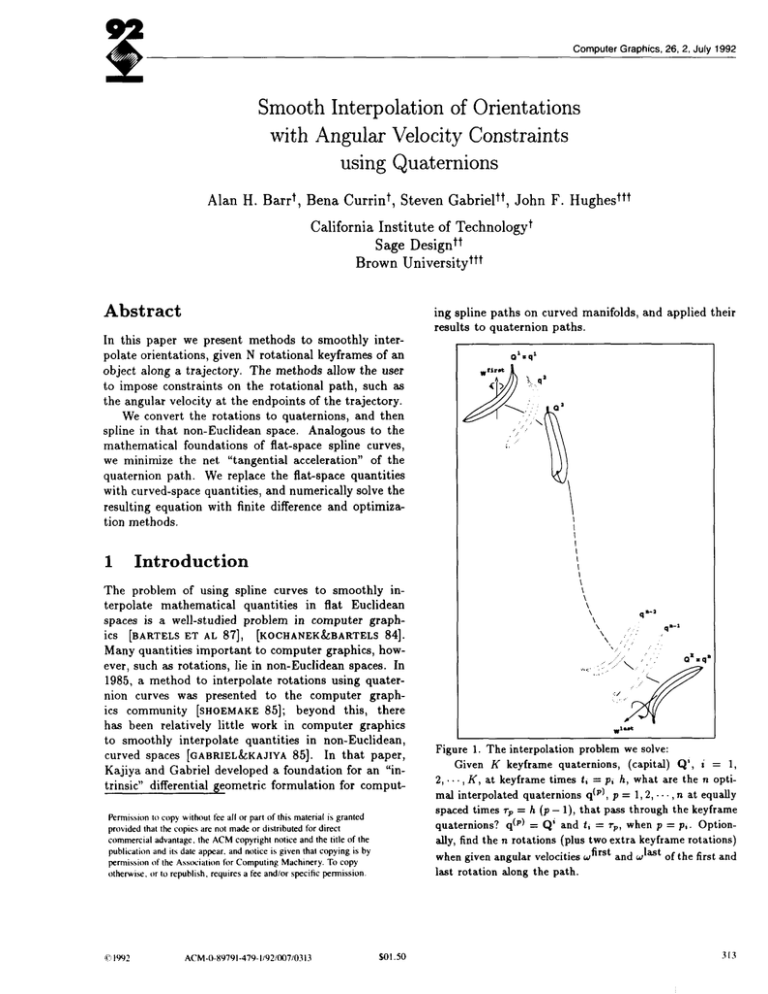
Computer Graphics, 26,2, July 1992
i?
Smooth Interpolation of Orientations
with Angular Velocity Constraints
using Quaternions
Alan
H. Barrt,
Bena
Currint,
California
Steven
Institute
Sage
Brown
Gabrieltt,
John
F. Hughesttt
of Technology
Designtt
Universityttt
Abstract
ing spline
results
paths
on curved
to quaternion
manifolds,
and applied
their
paths.
In this paper we present methods to smoothly interpolate orientations,
given N rotational
keyframesof
an
The methods allow the user
object along a trajectory.
to impose constraints
on the rotational
path, such as
the angular velocity at the endpoints of the trajectory.
We convert the rotations to quaternions, and then
spline in that non-Euclidean space. Analogous to the
mathematical
foundations of flat-space spline curves,
we minimize the net “tangential acceleration” of the
quaternion path. We replace the flat-space quantities
with curved-space quantities, and numerically solve the
resulting equation with finite difference and optimization methods.
\
I
I
1
Introduction
I
\
\
The problem of using spline curves to smoothly interpolate mathematical quantities in flat Euclidean
spaces is a well-studied problem in computer graphics [BARTELS ET AL 87], [KOCHANEK&BARTELS 84].
Many quantities important to computer graphics, however, such as rotations, lie in non-Euclidean spaces. In
1985, a method to interpolate rotations using quaternion curves was presented to the computer graph[SHOEMAKE 85];
beyond this, there
ics community
has been relatively little work in computer graphics
to smoothly interpolate quantities in non-Euclidean,
curved spaces [GABRIEL&KAJIYA 85]. In that paper,
Kajiya and Gabriel developed a foundation for an “intrinsic” differential geometric formulation for comput-
“\
\
q %2
\
q.-l
\
‘.:
\
\.\,..:
..
,
“’”’,
‘; ‘
,.
.:...
..
. ..
Q==q’
2?
‘,, ‘\
:/
-hoe
Figure
1. The interpolation
Given
2, ...,
K keyframe
problem
quaternions,
we solve:
(capital)
Q’,
: =
1,
K, at keyframe times t, = p, h, what are the n opti-
mal interpolated
quaternions q(p), p = 1,2, . . . . n at equally
spaced times rP = h (p —1), that pass through the keyframe
Perrnission 10 copy without fee all or part of [his material is granted
provided thal the copies are not made or distributed for direct
commercial advantage. the ACM copyrigh( notice and the title of Ihe
publication and its date appear. and notice is given that copying is by
permission of [he Awtxial!on for Computing Machinery. To copy
otherwise, or to republish, requires a fee and/or specific permission.
p ]y)~
ACM-()-89791-479-
1/92/007/031 3
quaternions?
q(p) = Qi and t,= TP,when p = p,.
Option-
ally, find the n rotations
when given angular
last rotation
$01.50
(plus two extra key frame rotations)
velocities w first and W1wt of the first and
along the path.
3[3
SIGGRAPH ’92 Chicago, July 26-31, 1992
Splining
in non-Euclidean
Spaces
This paper
presents
a simpler
version
of the
Gabriel/Kajiya
approach to splining on arbitrary manifolds, Our approach uses extrinsic coordinates and constraints (rather than intrinsic methods, Christoffel symbols and coordinate patches), and generalizes to other
manifolds that are embedded in Euclidean space.1 The
problem of computing spline curves on curved manifolds
is of increasing importance to computer graphics, and
we predict many future generalizations.
There are several reasons why someone would choose
to use our interpolation techniques:
●
The paths we generate through rotation space are
very smooth.
●
Our techniques allow the user to specify arbitrarily large initial and final angular velocities of a
rotating body; by assigning large angular velocities, a user can make an object tumble several full
turns between successive keypoints,
It is fairly easy to add additional
●
The techniques
other quantities
●
The techniques are fast enough to experiment
with, taking a few minutes per interpolation.
constraints.
dimensional manifold can be embedded in a 2 M + 1 dimensional
Euclidean space.
2The m~n ~vatage
is that quaternion constraints we simple to enforce (constructing
a four dimensional unit vector); the
representation:
there are two unit
quaternions that represent each rotation.
3For ~wbling bodies this is reasonable, but it is not completely
is double
true for camera orientations: certain orientation
(ones with no
“tilt” around line of sight of the camera) are far preferable to
others. We would need to determine the appropriate constraints
to minimize the net tilting.
314
Background
Shoemakers paper on quaternions provides a good introduction to the mathematics of quaternions and their
relationship to rotations. For our results, we need three
basic facts-about quaternions:
●
The set of unit-length quaternions (i.e., expressions of the form q = a + bi + cj + dlc with az +
b2+c2+d2 = 1) corresponds to the unit 3-sphere in
4-dimensions. The quaternion a + bi + cj + dk corresponds to the point (a, b, c, d). The same quaternion is denoted by q =
~
, where s =
a
and
()
of
Of course, we cannot claim to have solved all
problems of interpolating
rotations and orientations.
Through our choice of representation,
we will have
the classic advantages and disadvantages of using unit
quaternions to represent rotations.2
Also implicit in
our approach is the assumption that the geometry of
the space of orientations has a certain homogeneity, and
that we can mathematically specify all of the constraints
that we wish to apply.3
We find a path that minimizes a measure of net
bending.
We implement this, however, using a finite
difference technique, so that we end up with a sequence
of points on the path, rather than a continuous path. To
produce a continuous path, we use Shoemakers slerping
to interpolate between these points.
In section 2, we provide a brief discussion of quaternions, and present intuitive mathematical
background
to motivate the differences between interpolating in flat
space and curved spaces; in section 3 we sketch the overall algorithm; in section 4 we present the constrained
1whitney~s origin~ embedding theorem tells us that every M
main disadvantage
Mathematical
2
●
●
generalize to interpolations
in non-Euclidean spaces.
optimization
problem; section 5 speaks briefly about
numerical derivatives on manifolds; section 6 presents
methods to solve the problem, while section 7 presents
our results,
●
v = (h, c,d).
There is a natural map that takes a unit quaternion and produces a rotation: the quaternion a +
bi + cj + dlt corresponds to a rotation of 2 cos-l(a)
If (b, c, d) =
about the axis (b, c, d) in 3-space.
(O,O,O) the rotation angle is 2 Cos-’(zkl) = O, and
the rotation is the identity.
The map from unit quaternions
to rotations is 2to-1. For every rotation, two quaternions, +q and
–q, lying at antipodal ends of a hypersphere, correspond to it.
Advantages of quaternions. There are several reasons to use quaternions to describe rotations. First, the
quaternion space has the same local topology and geometry as the set of rotations (this is not true of the space of
Euler angles, for example, but is true of the 3 x 3 orthogonal matrices of determinant 1). Second, the number of
coordinates used in describing a quaternion is small (4
numbers, in contrast to the 9 in a 3 x 3 matrix). Third,
the number of constraints on these coordinates is small:
the only constraint on a quaternion representing a rotation is that it have unit length; a 3 x 3 matrix must
satisfy six equations to represent a rotation.
Finally,
the extrinsic equations for quaternions turn out to be
fairly simple.
Disadvantages of quaternions. The main disadvant age of using quaternions is that their 2-to-1 nature necessit ates a preprocessing step, to choose whether the
plus or minus keyframe quaternion is the appropriate
one to use.
Euclidean
and non-Euclidean-space
splines.
Since
the 3-sphere is a non-Euclidean space, we discuss interpolation methods for Euclidean spaces, and then motivate and describe a generalization
to non-Euclidean
Computer Graphics, 26,2, July 1992
spaces. We will informally refer to them as “flat” spaces
and “curved” spaces respectively.
2.1
Flat-space
interpolation
The Hermite formulation expresses a spline curve as a
parametric cubic curve ~(t) that starts and ends at two
given points4, T(O) = PO and v(1) = P1, and haa given
velocities there, i.e., ~’(0) = R“ and ~’(l) = RI. Given
these boundary conditions (i.e., PO, P1, Il”, and RI),
we can find a unique cubic path that satisfies them. But
why is a cubic the right curve to use?
One answer is given by reformulating
the problem to
ask “Among all curves starting at PO with velocity RO
and ending at P1 with velocity R1, what curve bends
the least?” We approximate the least square measure of
curvature by minimizing the net squared length of the
acceleration vector, ~“. Thus we seek to minimize
surface, its velocity vector will always be tangent to the
surface. Its acceleration vector, however, does not have
to lie within the surface. It is likely to have components
normal to the surface, as well aa components tangential
to the surface.
In Figure 2 we see a pair of curves on a surface. The
midpoint of the upper curve has an acceleration vector
a that points both out from the surface and up a little.
We see that the acceleration vector a is not parallel to
the surface normal IV; the “non-~ part” of vector a
acce/eratton
or covariant
accelemtion)
is
(the tangential
labeled Sin the drawing. The acceleration vector of the
lower curve actually coincides with the normal vector to
the surface, and hence its tangential acceleration is zero.
I
1
-y’’(t) -y’’(t)dt
E=
(1)
/o
over all paths ~ that satisfy the boundary
conditions.
The Euler-Lagrange
equations
[ZWILLINGER 89] provide a necessary condition for v to be a minimum. Writing out these conditions
gives T“” = O, which means
that each component
of ~(t) must be a cubic function
oft,
A physical
implementation
of splines
in a flat
space.
The word “spline” originally referred to a
thin strip of wood or metal that was constrained by
pins to form smooth curves for drafting or shipbuilding. For drafting, the pins were placed onto a flat surface; for shipbuilding, rigid posts were inserted into the
earth, and wooden flexible planks were threaded between them. In each case, the splines flexed to meet the
positional constraints imposed by the pins or posts. The
spline took on curved shapes in its attempt to achieve
a low-energy state, governed by equation (1).
2.2
Flat space
splines
space splines.
versus
Figure
2. Two curves on a curved surface.
The upper curve
has an acceleration vector a, that does not lie in the surface.
The vector N is the normal vector to the surface, along the
path. The tangential
part of the acceleration
is the vector
S = a \ N (described
in section
acceleration
acceleration.
to N, hence it has zero tangential
is parallel
2.3).
The
lower curve’s
curved-
We would like to carry out an analogous computation
in a curved space: we define a “bending” measure of a
curve, and then determine which curves minimize the
measure. Unfortunately, the ordinary second derivative
of a path is no longer the right way to measure net
“bending.” We can understand this by considering the
problems that arise even for surfaces in 3-space.
If ~ is a path on a surface M in 3-space, then 7 can
be thought
of as a path in 3-space as well. As such,
at each time t the path has a velocity vector -+(t)and
an acceleration vector ~“(t).Because 7 lies within the
4We use superscripts to indicate different vectom, and subscripts to denote z, y, z, etc components of vectors.
A physical analogy. Imagine driving in a small circle
in a hilly region. You feel two sorts of acceleration: you
bounce up and down in your seat as you go over bumps,
and you are pushed against your car door because you
are turning in a tight circle. The first is acceleration
in the direction normal to the surface of the earth; the
second is the tangential acceleration.
Note that if you
want to take a drive, any path you take is likely to
have some net tangential acceleration. But to make the
trip as comfortable as possible, minimizing tangential
acceleration is desirable.
Normal acceleration
is inevitable.
By contrast, the
normal component of the acceleration is a necessary evil.
Imagine trying to get from one place on a sphere to an315
SIGGRAPH ’92 Chicago, July 26-31, 1992
other in a way that minimizes total acceleration. If you
travel along a great circle at a constant speed, the only
acceleration will be normal. If you try to adjust your
path so that you undergo no acceleration, you will have
to be traveling in a straight line in 3-space, and hence
will have to leave the surface of the sphere. This gets rid
of the normal acceleration, but at the cost of violating
the requirement that -y be a path on the surface.
Another
physical example.
Let us consider making a
physical spline onto a spherical globe. Instead of placing
pins into a flat drafting surface, we push the pins into
the globe itself. We thread a semi-rigid elaatic strip
through the pins, making sure that the strip stays on
the globe while being constrained by the pins. Since the
strip needs to stay on the globe, we do not penalize it
for bending to stay on the globe.
These examples motivate why we do not penalize
acceleration normal to the surface, while penalizing acceleration within the surface, for constructing splines
In generalizing Equation 1 to
on curved surfaces.
curved spaces, Kaji ya and Gabriel therefore replaced
the squared length of the acceleration vector with the
squared length of the tangential acceleration.
This is
the starting point for our solution: we will seek a path
in quaternion space, i.e., a path on the unit 3-sphere
in 4-space, that minimizes the total squared tangential
acceleration.
2.4
Physical
meaning
quaternion
sphere
Given
project
tor a.
vector
A formula
tion
for
tangential
3
Algorithm
(a\
in
accelera-
Appendix
‘hich
‘mpl’es
‘hat
o = (b.
b)
= -f’’(t)
\ ~(t),
For other applications, the formula for tangential acceleration of a curve on an arbitrary implicitly defined surface
f(z) = O is
S(t) = ~“(t) \ N, where
N = Vf.
316
slerp
desired
in
section
the
between
the
quaternions
inuous
shoun
quaternions
interpolated
(a ~b)
described
between
3. Optionally
as
optiraization
as
compute
rotation
If the surface M is a unit sphere, then the unit normal at the point (a, b, c) is (a, b, c). So for a path ~
on the unit sphere, the total acceleration
at time t is
~“(t); its normal vector is ~(t) itself, and the tangential
acceleration S(t) is given by
s(t)
constrained
4. Convert
Qi
A
interpolated
keyframes.
such that
into
quaternions,
techniques
b). b=O
.
orientations
key frame
cent
.
the
Description
1. Preprocess
two n dimensional vectors a and b, we wish to
away and remove all portions of b found in vecThe notation we use for this is a \ b (read as
a “without” vector b). By definition,
ab,
on
We provide a sketch of the overall algorithm in figure 3,
using the curved-space results of the previous sections.
In the subsequent few sections, we develop the mathematics for step 2. The implementation
for step 2 is
found in section 6.
6 to
a\ b=a–
paths
We have already noted that each unit quaternion corresponds to a rotation. If we think of this rotation acting
on a rigid body in a “home” coordinate system, then we
can say that each quaternion corresponds to an orientation of the rigid body. Therefore a path in the quaternion sphere represents a continuously changing orientation. The derivative of the path at a particular instant
represents the rate of change of orientation of the body,
essentially its angrdur velocity. Thus to specify the endpoints and end tangents of a quaternion curve means to
specify the initial and final orientations of a rigid body
and its angular velocities at those points.
2. Use
2.3
of
represent
the
form)
get
a
at ion.
quaternions
matrices
to
(or
back
into
other
.
—
Figure
4
3. The steps of the algorithm.
Mathematical
Formulations
In this section, for our constrained optimization problem, we consider some of the merits of using a continuous derivative versus using discrete derivatives.
Ultimately we will choose the discrete approach, because it
is simpler. The reader should not infer that continuous approaches are not worthy of further investigation,
however.
Computer Graphics, 26, 2, July 1992
4.1
Continuous
derivative
approach
Thus, we minimize the function
The problem statement for the continuous version without angular velocity constraints is: given K keyframe
quaternions, Ql, Q2, . ~, QK, at times tl, tz, . . .. t~,
what is the unit quaternion curve -y(t) of minimal net
least square tangential acceleration that passes through
the points?
We are looking for the unknown (four dimensional)
unit magnitude quaternion function ~(t) which minimizes t, the net square magnitude of the tangential acceleration. Without loss of generalit y,5 we stipulate that
tl = O. Thus we minimize
~*K l#(t)
&=
\ -f(t)[2
dt
/
Pu..x
E(q)
=
h ~
(q(p))” \ q(p) 2
P=Pmin
subject to the constraints
boundary
values
~(P!)
:
magnitudes:
lq(p)l
that
=
Q’, inl,z,...,K
=
1,
p=
1,2, . . ..n.
The p: are those values ofp where we wish the interpolated quaternions q@J to coincide with the keyframe
quaternions Qi. Pl=l,
andl-k=n;prnin=l
or2
and pmax = n or n – 1. They are chosen so that (q(p) )“
can be computed in each term in the sum. (This is
equivalent to having a weighting factor in the sum).
subject to the constraints
boundary
values
magnitudes
:
V(ti)
=
Qi,
:
17(t)l
=
1,
i = 1,2,...,
4.3
equation.
The
authors
have
Discrete
derivative
approach
of the function
(q(p)
),,
@’+l)– 2q(P) + q(P-l)
=
h2
We now have a calculus problem: find the n quaternions
q@’1that minimize the scalar function f?(q) subject to
the above constraints.
Without the angular velocity
constraints we let pmin = 2 and pmaX = n — 1.
4.4
Angular
velocity
constraints
de-
If we do not wish to solve K-point boundary value problems, we can make discrete approximations
to convert
the calculus of variations problem into a calculus problem. Instead of solving for an unknown function 7(t),
q@J, p = 1,2, . . . . n. We
we solve for n fixed quaternions
retain the constraints that each q@’) is a (four dimensional) unit vector, and that the appropriate q(p’ls coincide with our key frame quaternions Qi, i = 1, 2, . . . . K.
We replace the continuous derivatives ~(t)” in the
& equation with a numerical approximation,
shown in
section 4.3; we denote the discrete derivative approximation with (q@))”, and compute them from the q@)s.
In addition, we replace the integral with a discrete approximation, the sum of about n equally spaced values,
times the stepsize, h = tK/(n – 1).
5The reader can shift the arguments
a tl # O problem to a tl = O problem.
derivatives
three-point formula:
rived this equation, but feel it would needlessly clutter
the presentation.
The approach involves the solution
of a K-point ODE boundary value problem with constraints; we leave the pursuit of this approach as future
work,
4.2
second
A simple discrete version of the second derivative is the
0 ~ t ~ tK
The boundary value constraints ensure that the
quaternion path passes through the key frame quaternions; the unit magnitude constraint keeps the quaternion on the unit 3-sphere. tK and O are the (prescribed)
values of t at the endpoints of the quaternion path.
This constrained optimization
problem is a calculus of variations problem, which produces an EulerLagrange ordinary differential equation formulation
form
with constraints [ZWILLINGER]. It is an extrinsic
of the Gabriel/Kajiya
Discrete
K.
to reduce
Sometimes,
we may wish to stipulate that angular veloc-
ities Ufirst and UIMt apply to the first and last rotations
along the path.
We can stipulate
that the angular velocity is
—h < t <0
and
constant
over the time interval
t~ < t < tK + h. We reduce the problem with angular velocity constraints
into the previous case, creating
new quaternions
and new constraints
q(o) = QO and
q(~+l) = QK+l. TO compute QO, let
Wfirst
w=
O =
Qo
To compute
hlw{’
w/lwl
=
w
(
=
QK+l,
=
d=
@+l
QI
)
let
Wlast
w=
0
c:f3@/2)
– sln(O/2) d
hlwl’
w/{wl
=
(
c0s(8/2)
QK
sin(O/2) & )
Thus, the method involving angular velocity constraints is merely a renumbered version of the previous
317
SIGGRAPH ’92 Chicago, Juty 26-31, 1992
We let pmin = 1 and p~ax = n, to add the two
points. These points are the two smaller dots in figure
8.
First, you need the constraint
function
p-th quaternion
on the unit sphere
5
Then construct a total energy J’(q) by adding the constraint
and penalty terms
method.
Numerical
3-sphere
derivatives
on the
There are three problems that typically arise when using
numerical methods to approximate
derivatives on a manifold. First, some derivative formulas are not centered – they
approximate
the derivative, but not at the specified point.
Secondly, there is a numerictai accuracy problem – numerical
approximations
of the derivative typically will not lie in the
tangent plane. Finally, there can be an aliasing problem,
particularly for paths which circumnavigate
the sphere or
travel in tight loops. The aliasing problem greatly accentuates the numerical accuracy problem.
We compute our numerical derivatives using the centered
three point formula for the second derivative shown in section 4.3. To solve the aliasing problem, we must choose
n, the number of samples of g(p) to be large enough so
that aliesing effects are not significant.
To reduce &sing, we suggest maintaining
enough interpolation
points
so that adjacent q(p)s do not travel more than +1/4 way
around the sphere, which can be tested via the condition
#’J . g(PtlJ >0. )?OI inst ante, between antipodal keyframe
quaternions,
two or more intervening
are needed.
For the angular velocity constraint,
suggests maintaining
lelc
interpolation
a similar
points
6
Implementing
the
derivative
method
E(q), subject to the constraints.
By using first and second
derivatives of the energy function E(q), you can speed up
the solutions significantly.
An advantage of thm approach is that the packaged algorithms implement a robust convergence test, to determine
when the optimal solution is found.
Lagrangian
constraints
If the implementer
does not wish to use prepackaged
algorithms, a practical approach is to implement a variation of
the Lagrangian methods in [PLAIT 88], using first-derivative
information. (We leave the implementation of faster meth-
ods, with quadraticconvergence,as future work.)
318
If r c ~min + l,pma= - 1], the above equation is valid.
If r = pmin -1, only the r + 1 term applies and the others
are deleted; if r = Pmi., the r + 1 and r terms apply, but
the first term is deleted; if r = p~a, + 1, only the first term
applies, while if r = Pm,,, the first three terms
Then, set up the differential equations
d
(r)
z ‘~
s
-&F(q),
‘
-gA,
=
and set up appropriate
r=pl,
apply.
r#pi
~qp
‘(r)=o
discrete
ql(r) and with respect
to A,
Zqt
whichsolves for the q(p) can be used, aa long as it minimizes
Augmented
with respect to
and take its derivative
~/2.
The most reliable way to implement the algorithm, whether
or not angular velocity constraints
are used, is to use a constrained optimization
package for sparse systems, such as the
MINOS package [MURTAGH8ZSAUNDEHS83]. Any method
6.1
P=Pmi.
condition
This implies that we need n > # Idl t~., steps, where [dl is
the magnitude of the larger of the two angular velocities.
which keeps the
‘=pi
+gr(q)
initial
conditions:
q:) (0)
=
Q)
i=l,...,
q\r) (0)
=
interpolated
values
flat-space or results
smaller numbers of
ditions significantly
method
K,
lz0,1,2,3.
between the Q&, either
from previous runs with
points. Better initial conimprove the speed of this
Ap=l
Numerically solve the differential equations with an automatic stepsize
method (such as Adarns method),
until
you reach sufficiently constant values. This heuristic “stop”
condition is why we advocate using packaged optirniiation
algorithms, which have robust stop conditions.
It is recommended
that the program be structured
so
points
that output from a smaller number of interpolated
can be used to set up the initial conditions for a run with a
larger number of interpolated
points.c
6you cm &o trmfom
the variables in the differential eqution via s = 1 + 1/(0 - 1), essentially scaling the right hand side
by 1/(1 - u’). The solution will then be found at u = 1, rather
than at s = co; you can iterate, numerically integrating the transformed differential equation repeatedly from O to 0.999 until the
termination
condition is reached.
Comwter
7
Graphics, 26, 2, July 1992
Results
In the following figures, we show quaternion
points visualized
in three dimensions:
we chose quaternions
with the k component set to zero. Internally, of course, the implementation
is fully four dimensional.
We implemented
augmented
Lagrangian constraints,
as well as a prepackaged
version. The
two methods agreed within the prescribed
tolerances.
Figure 6a. Here we specify
straints,
doubling
asymmetric
angular
until the path goes around
velocity
con-
the sphere.
1
I
Figure 4a. Two keyframe
constraints
(shown
rotations,
as dots)
without
angular
on the interpolated
velocity
Figure
path.
6b. The object
rotates
twice around.
Figure 4b. The corresponding
rotational
path of the object.
The two yellow objects are the two keyframe rotations,
while
the green images
are the interpolated
draw only a subset
of the interpolated
values.
For clarity,
we
values.
Figure
there
Figure
7a. Here we have seven keyframe
are 199 interpolated
quaternion
points;
are clearly
visible.
points.
7b. The seven keyframe
rotations
Figure 5a. We go half-way around the quaternion
sphere for
the same initial and final rotation, by choosing the antipo da1
point,
-Q’.
We rotate
Figure
5b. The rotational
more fully around
path
in space.
of the object
in 5a.
Figure 8. Symmetric angular velocity constraints
are applied
to the same endpoints
in 4a. Note the two extra points, Q”
and Q1’+r,
drawn
with smaller
dots off of the curve.
SIGGRAPH ’92 Chicaao, July 26-31, 1992
Notes. In the figures, the keyfrarne quaternions are drawn
with larger dots, while the keyframe quaternions
from the
angular velocity constraints
are drawn with smaller dots.
Note the qualitative
similarity with flat-space splines. The
banana rotates more in figure 5b than in 4b, due to the
antipodal representation
of the left rotation.
Since the algorithm finds local mtilma, a different solution with a ditTerent
number of loops might turn out to be the absolute minimum.
The method, for large numbers of points, prefers good initial conditions, such as those produced by the algorithm with
fewer points.
points are used
For figures 7a and 7b, 32 interpolation
in each interval, for a total of 199 points. The schedule of
increasing points in each interval was 5 ~ 8 ~ 16 * 32.
The total computation
time on an HP 700 was less than
four minutes.
8
Conclusions
We have presented a new technique to smoothly interpolate rotations using quaternions.
The method
uses an extrinsic version of Kajiya and Gabriel’s bendminimization
to characterize a spline in the quaternion 3-sphere; such splines are natural generalizations
of splines in Euclidean space, and are particularly
amenable to solution on the 3-sphere. We use a numerical method to determine several points between the key
orient ations; Shoemakers slerping can be applied to the
points; the resulting splines are smooth, and have the
desirable property that they pass through their control
points exactly.
Our preliminary results are favorable, but there is
much that can still be done to improve on this technique. We believe that splining in curved spaces will
be of increasing importance to computer graphics, and
predict many future generalizations.
Acknowledgements
The authors wish to thank Mark Montague, John Snyder, David Laidlaw, and Jeff Goldsmith at the Caltech graphics lab, as well as the Siggraph reviewers, for numerous helpful suggestions.
The banana
database is a generative model made by John Snyder
and Jed Lengyel. This research was supported by the
NSF/DARPA
STC for Computer Graphics and Scientific Visualization, and by grants from HP, IBM, DEC
and NCR to the university laboratories.
References
[1] R. Bartels, J. Beatty, and B. Barsky. An introduction to Sphnes for Use in Computer Graphics
and Geometrr”cModeling. Morgan Kaufmann, Los
Angeles,
320
1987.
[2] S. Gabriel and J. Kajiya. Spline interpolation in
curved space. In “State of the Art Image Synthesis,” Course notes for SIGGRAPH ’85, 1985.
[3] W. R. Hamilton. Lectures on Quaternions.
and Smith, Dublin, 1853.
Hodges
[4] D. Kochanek and R. Bartels. Interpolating splines
with local tension, continuity, and bias control.
Computer Graphics, 18(3):33-41, July 1984.
[5] R. S. Millman
Diflerentiai
Elements of
and G. D. Parker.
Prentice-Hall,
Englewood
Geometry.
Cliffs, NJ, 1977.
[6] B. A. Murtagh and M. A. Saunder. MINOS 5.(I
user’s guide. Technical Report SOL 83-20, Dept.
of Operations Research, Stanford University, 1983.
[7] Ltd Numerical Algorithms Group.
library routine document, 1988.
[8] J. Platt.
Constraint
methods
NAG Fortran
for flexible
models.
Computer Graphics, 22(4):279-288, July 1988.
[9] W.H. Press, B.P. Flannery, S.A. Teukolskym, and
W .T. Vetterling. Numericai Recipes in C... Cambridge Univ. Press, Cambridge, England, 1988.
[10] K. Shoemake. Animating rotation with quaternion
Computer Graphics, 19(3):245-254, July
curves.
1985.
A C’omprehensiue Introduction to Differential Geometry. Publish or Perish, Inc., Boston,
[11] M. Spivak.
1970.
[12] D, Zwillinger. Handbook of Differential Equations.
Academic Press, San’ Diego, 1989.
Appendix
ate Spin
A: Preprocessing
Step
to Cre-
First, convert the K rotation matrices into K quaternions (see Shoemake or other quaternion reference for
details). Then choose the desired spinning behavior of
the objects between the quaternions. Sometimes, the
object is desiredto undergo an odd numberof full spins
around on an interval (usually once). These will be the
“odd” intervals (and the other intervals are regarded
as “even ,“ which usually do not spin around).
Mu]tiplying a quaternion by – 1 does not change the orientation it represents, but it does change whether or
not an even or odd number of full-spins around the object takea place. The dot product of adjacent keyframe
quaternions should be greater than or equal to zero for
the even intervals, and less than zero for the odd ones.
Multiply the quaternion by by –1 to change the interval
from one state to the other.
